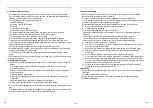
– 2 –
1
PRECAUTIONS FOR SAFETY
• Ensure that installation work satisfy all Local, National International regulations.
• Read this “PRECAUTIONS FOR SAFETY” carefully before installation.
• The precautions described below include the important items regarding safety. Observe
them without fail.
• After the installation work, perform a test operation to check for any problem.
Follow the Owner’s Manual to explain how to use and maintain the unit to the customer.
• Turn off the main power supply switch (or breaker) before the unit maintenance.
• Ask the customer to keep the Installation Manual together with the Owner’s Manual.
•
Ask an authorized dealer or qualified installation professional to install / maintain
the air conditioner.
Inappropriate installation may result in water leakage, electric shock or fire.
•
Turn off the main power supply switch or breaker before attempting any electrical
work.
Make sure all power switches are off. Failure to do so may cause electric shock.
•
Connect the connecting wire correctly.
If the connecting wire is connected in a wrong way, electric parts may be damaged.
•
When moving the air conditioner for the installation into another place, be very
careful not to enter any gaseous matter other than the specified refrigerant into
the refrigeration cycle.
If air or any other gas is mixed in the refrigerant, the gas pressure in the refrigeration
cycle becomes
abnormally high and it as a result causes pipe burst and injuries on persons.
•
Do not modify this unit by removing any of the safety guards or by by-passing
any of the safety interlock switches.
•
Exposure of unit to water or other moisture before installation may cause a short-
circuit of electrical parts.
Do not store it in a wet basement or expose to rain or water.
•
After unpacking the unit, examine it carefully if there are possible damage.
•
Do not install in a place that might increase the vibration of the unit.
•
To avoid personal injury (with sharp edges), be careful when handling parts.
•
Perform installation work properly according to the Installation Manual.
Inappropriate installation may result in water leakage, electric shock or fire.
•
When the air conditioner is installed in a small room, provide appropriate
measures to ensure that the concentration of refrigerant leakage occur in the
room does not exceed the critical level.
•
Install the air conditioner securely in a location where the base can sustain the
weight adequately.
•
Perform the specified installation work to guard against an earthquake.
If the air conditioner is not installed appropriately, accidents may occur due to the falling
unit.
WARNING
•
If refrigerant gas has leaked during the installation work, ventilate the room
immediately.
If the leaked refrigerant gas comes in contact with fire, noxious gas may generate.
•
After the installation work, confirm that refrigerant gas does not leak.
If refrigerant gas leaks into the room and flows near a fire source, such as a cooking
range, noxious gas might generate.
•
Electrical work must be performed by a qualified electrician in accordance with
the Installation Manual. Make sure the air conditioner uses an exclusive power
supply.
An insufficient power supply capacity or inappropriate installation may cause fire.
•
Use the specified wires to connect them to the terminals. Securely fix them so
that the external tension to the wires do not affect the connecting part of the
terminals.
•
Conform to the regulations of the local electricity company when wiring the
power supply.
Inappropriate grounding may cause electric shock.
•
Do not install the air conditioner in a location subject to a risk of exposure to a
combustible gas.
If a combustible gas leaks, and stays around the unit, a fire may occur.
•
This Air Conditioner has adopted a refrigerant HFC (R32 or R410A) which does
not destroy the ozone layer.
- As the R32 or R410A refrigerant is easily affected by impurities such as moisture,
oxidized film, oil, etc., due to the high pressure, be careful not to allow the moisture,
dirt, existing refrigerant, refrigerating machine oil, etc., to get mixed up in the
refrigeration cycle during the installation work.
- A special tool for the R32 or R410A refrigerant is required for installation.
- Use a new and clean piping materials for the connecting pipe so that moisture and dirt
are not mixed together during the installation work.
•
Tighten flare nuts using a torque wrench according to the specified method.
If the flare nuts are tightened too much, they may later break and cause refrigerant leak.
•
Wear protective gloves during installation.
Failure to wear the gloves causes an injury on your hands through contact with parts.
CAUTION
3-EN
4-EN



































